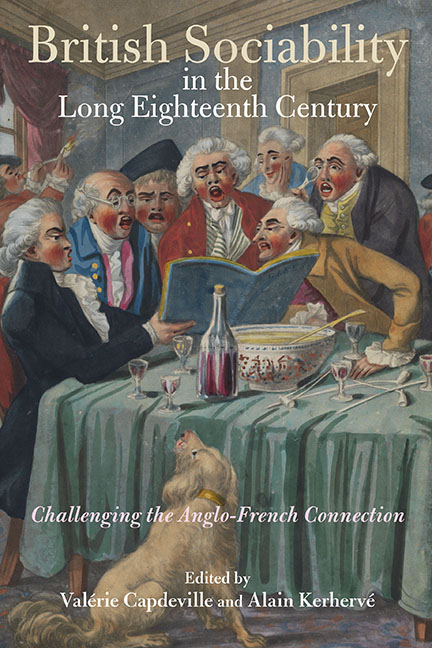Book contents
- Frontmatter
- Contents
- List of illustrations
- List of contributors
- Foreword
- Acknowledgements
- Introduction
- Part 1 Emergence of new political and social practices
- Part 2 Competing models of sociability
- Part 3 Paradoxes of British sociability
- 10 In company and out: the public/private selves of Johnson and Boswell
- 11 Friendship and unsociable sociability in eighteenth-century literature
- 12 The anti-social convivialist: toasting and resistance to sociability
- 13 Sociability and the Glorious Revolution: a dubious connection in Burke's philosophy
- 14 Respectability vs political agency: a dilemma for British radical societies
- Conclusion
- Bibliography
- Index
11 - Friendship and unsociable sociability in eighteenth-century literature
from Part 3 - Paradoxes of British sociability
Published online by Cambridge University Press: 18 September 2019
- Frontmatter
- Contents
- List of illustrations
- List of contributors
- Foreword
- Acknowledgements
- Introduction
- Part 1 Emergence of new political and social practices
- Part 2 Competing models of sociability
- Part 3 Paradoxes of British sociability
- 10 In company and out: the public/private selves of Johnson and Boswell
- 11 Friendship and unsociable sociability in eighteenth-century literature
- 12 The anti-social convivialist: toasting and resistance to sociability
- 13 Sociability and the Glorious Revolution: a dubious connection in Burke's philosophy
- 14 Respectability vs political agency: a dilemma for British radical societies
- Conclusion
- Bibliography
- Index
Summary
WHEN COINING the term ‘unsociable sociability’ in his ‘Idea for a Universal History with a Cosmopolitan Aim’ (1784), Immanuel Kant was working within a long philosophical tradition that identified human society as a site of conflicting sociable and moral impulses. To recognise resistance to sociability as a necessary quality of sociability itself was in one sense to align oneself with a strand of social thinking that emphasised the positive outcomes of apparently evil inclinations in human nature. Such an outlook had been epitomised in Britain earlier in the eighteenth century by the works of Bernard Mandeville; Kant's insistence on the value of competition for social development likewise had much in common with Adam Smith's analysis in The Wealth of Nations (1776). However, in describing the paradox of humanity's sociability – its ‘propensity to enter into society … combined with a thoroughgoing resistance that constantly threatens to break up this society’ – Kant also needed to allow for the weight of genuine altruism and virtuous instinct as a counterbalance to self-interest, and in this he was just as much an heir to the optimism of the likes of the third Earl of Shaftesbury and Frances Hutcheson. The intellectual basis for the idea of ‘unsociable sociability’ was thus variegated and contradictory, in keeping with the tensions inherent in the idea. The aim of this chapter is not to trace the tortuous etiology of Kant's concept through centuries of social philosophy, but instead to demonstrate its applicability to a trope of political writing that held particular sway in Britain of the 1730s and 1740s: the figure of the friendly enemy. I will argue through an examination of this figure's various guises and its relevance for the Patriot opposition both that it enacts the dramas of social resistance that would so fascinate Kant, and that it operates in itself as a manifestation of those dramas, a recurring point of conflict between the author's will to engage with the world and an unsocial desire for consensus and compliance. By exploring how these opposing impulses are presented and managed within texts of the time, one can gain a new appreciation of the long-standing currency of Kant's assumptions, as well as a more specific understanding of how this political movement navigated issues of sociability, dissension and individual resolve.
- Type
- Chapter
- Information
- British Sociability in the Long Eighteenth CenturyChallenging the Anglo-French Connection, pp. 199 - 218Publisher: Boydell & BrewerPrint publication year: 2019

